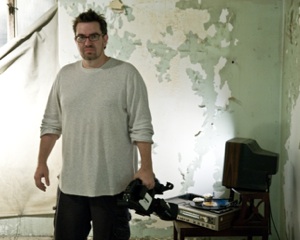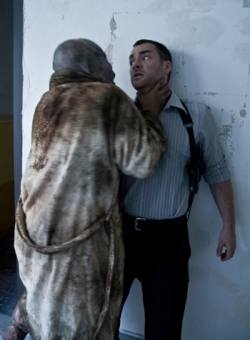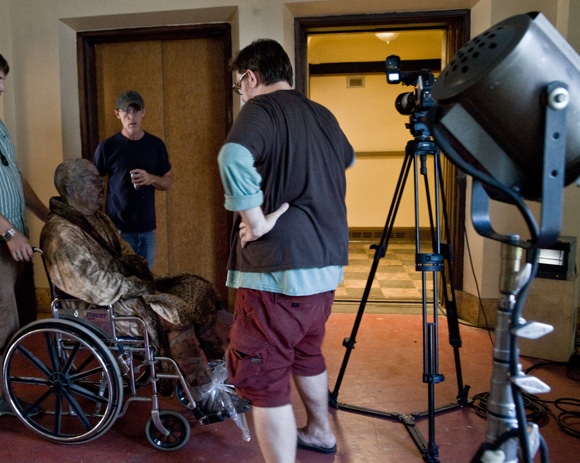 To create the entertainment of the future, writer-director Drew Daywalt reaches back into the past to fuel his imagination. The creator of Camera Obscura, the upcoming supernatural thriller web series from MWG Entertainment, draws much of his inspiration from the short form storytelling of the late 19th and early 20th centuries, focusing on the horror of anticipation. Camera Obscura shares the sense of dread prevalent in such literary classics as Edgar Allan Poe’s “The Raven,” and the works of H.P. Lovecraft.
To create the entertainment of the future, writer-director Drew Daywalt reaches back into the past to fuel his imagination. The creator of Camera Obscura, the upcoming supernatural thriller web series from MWG Entertainment, draws much of his inspiration from the short form storytelling of the late 19th and early 20th centuries, focusing on the horror of anticipation. Camera Obscura shares the sense of dread prevalent in such literary classics as Edgar Allan Poe’s “The Raven,” and the works of H.P. Lovecraft.
The series follows Clara, an orphan brought up by her alcoholic, absent grandfather. After he dies, she finds a camera that belonged to him, and discovers that it can capture demons. She also discovers that her grandfather’s work was not done, and it falls on her shoulders to complete his task. It’s a nice little family story with a whole lotta’ scary going on.
The cast features familiar faces such as Reagan Dale Neis (Malcolm in the Middle) as “Clara,” Timm Sharp (Till Death), and three-time Emmy winner and Golden Globe winner Jack Klugman as “Grandpa Sam.” Daywalt had previously worked with Neis and Sharp on his feature debut, Stark Raving Mad, and he wrote the parts in Camera Obscura with them in mind. He was thrilled when Klugman agreed to do the series, excited by the sense of weight and history the performer would bring to the role.

Subscribe to get the latest creator news
 While shooting, Daywalt told Klugman that he was surprised he had taken the role in Camera Obscura, given that Klugman hadn’t done anything paranormal since Rod Serling and The Twilight Zone. “Jack paid me one of the biggest compliments of my life,” says Daywalt. “He said ‘That’s because that was the last time someone handed me a script that was paranormal that’s this good.’ You can imagine how that felt!”
While shooting, Daywalt told Klugman that he was surprised he had taken the role in Camera Obscura, given that Klugman hadn’t done anything paranormal since Rod Serling and The Twilight Zone. “Jack paid me one of the biggest compliments of my life,” says Daywalt. “He said ‘That’s because that was the last time someone handed me a script that was paranormal that’s this good.’ You can imagine how that felt!”
Six creature actors are featured in Camera Obscura alongside the series leads, and a decent chunk of the budget was dedicated to practical – as opposed to digital – effects. The production shot for two five-day weeks with a crew of nine at locations that included the abandoned Linda Vista hospital in downtown Los Angeles. Daywalt shot in standard definition on the Canon XL2. Though others pushed him to shoot on HD, Daywalt insisted on standard def because he needed a camera that would handle low light situations well…and not expose everything in his special effects.
At first glance, Camera Obscura might seem like a strange match for MWG. The company’s mission is to produce and distribute original digital content for the adult female demographic. In contrast, the horror genre’s main audience is comprised of testosterone-laden teen-age boys. MWG’s first series, My Two Fans, is a comedy about dating; their second, Road to the Altar, is a wedding mockumentary. So where the heck does a story filmed in a creepy deserted hospital, populated with creatures named Mr. Hurt, Splinter and The Bag fit in to MWG’s development slate?
Max Goldenson, President of MWG, explains, “Camera Obscura is a supernatural thriller, and it certainly does have a great deal of special FX and is definitely visually jarring, but when you peel back that layer of spectacle and imagery, it’s the story of a young woman getting over the death of her grandfather. Everything else in the series ties into that relationship – the creatures, the puzzles, the allegory, all of it. It’s a much more complex and intimate way to tell that story, but that’s one of the reasons we felt it would be such a great fit for the web. We believe the women we’re targeting, historically and currently, are drawn to stories steeped in horror and suspense, particularly when it’s this intricate.”
 As a studio, MWG put up the funding for the series and owns the rights, though there is a backend profit participation deal in place with Daywalt. MWG plans to monetize the series via a combination of ad sales, sponsorship and brand integration. They work with a brand integration agency that specializes in these deals for web, TV and film, and their goal is to make deals that reflect the niche audience specific to each of their projects. They are currently in talks with a specific brand sponsor for Camera Obscura, but have not yet announced a deal.
As a studio, MWG put up the funding for the series and owns the rights, though there is a backend profit participation deal in place with Daywalt. MWG plans to monetize the series via a combination of ad sales, sponsorship and brand integration. They work with a brand integration agency that specializes in these deals for web, TV and film, and their goal is to make deals that reflect the niche audience specific to each of their projects. They are currently in talks with a specific brand sponsor for Camera Obscura, but have not yet announced a deal.
The decision to work with Daywalt was much simpler. Goldenson and MWG vice president of development Robert Kandle immediately knew they wanted to meet with the filmmaker after seeing some of the films on the web that he had done with Fewdio, the horror collective that Daywalt founded with a group of like-minded content creators.
In 2007, with the writers strike looming, Daywalt, writer-director David Schneider, former Newmarket exec John Crye, and actors Paul Hungerford and Kirk B.R. Woller decided to join forces. Says Daywalt, “We were all looking at six months of being completely unemployed. We knew the strike was going to last, and we needed to do something. We also wanted to reinvent ourselves. All five of us are big fans of genre.”
The group invested in equipment, taught themselves how to edit and got to work shooting horror shorts for the web based on the shared aesthetic of anticipatory dread rather than terror. When they first started, however, they got a lot of raised eyebrows. Many of their friends and colleagues expressed doubts about the potential for short-form horror to succeed on the web. They kept hearing, “The Internet is for comedy – guys falling down and landing on their balls, kittens playing piano, dudes wearing 164 shirts.”

But Fewdio is composed of a group of savvy artists who know their genre’s history, so they kept the faith. Daywalt points out that horror has historically been short-form. “The campfire tale isn’t a two-hour epic,” he jokes. “There were very few novels that were horror novels – they were mostly short stories, they were in pulp. Horror has always been sort of a red-headed step child to literature in all forms, whether it’s pop, film or written.”
For inspiration, Fewdio looked to people like Rod Serling, whose focus was on storytelling as opposed to slash. Their shorts received a warm embrace from some of the group’s favorite horror critics, such as Fangoria, and last year Wes Craven chose the collective’s Breach as one of his YouTube Halloween favorites. They just released an anthology DVD of their first batch of films.
The experience Daywalt gained doing the web shorts prepped him well for Camera Obscura. He got used to leaner and meaner budgets, and learned a few tricks of the trade for storytelling on the web. For example, he believes it’s important to develop a visual shorthand for each piece, establishing characters onscreen in an instant, while at the same time avoiding stereotypes.
Another challenge Daywalt grappled with during the writing process was figuring out how to create a series that was germane to the web. He didn’t want Camera Obscura to feel like a longer piece that had just been chopped up into 6-minute segments for online distribution. He eventually found his solution in he way he structured the episodes.
Explains Daywalt, “I approached each episode like it’s own short story that had an opening with a dramatic question, a resolution to that dramatic question and usually a cliff hanger ending that would draw you back to the next episode. Sort of an abrupt cut to black, hopefully leaving the audience going OH MY GOD!”
Camera Obscura is currently in post-production, with an anticipated October 12th launch date on a variety of platforms.
Photos courtesy of MWG.








